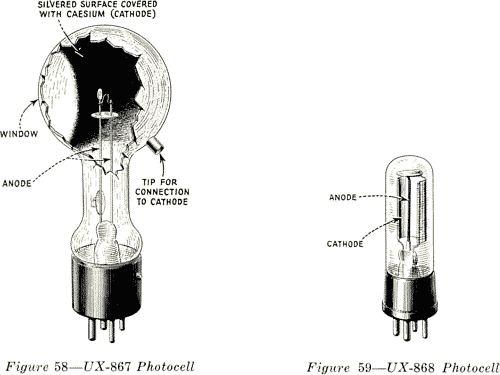|
85. Photo-Electric Cells.-A photo-electric cell is a device which varies in electrical resistance
in proportion to the amount of light falling upon it. Although there are various devices to which
this description might apply, the photo-electric cell used in "talking movie" sound reproducers,
as made by the leading manufacturers of such equipment, make use of the fact that when
light falls upon the surface of a metal, electrons are emitted from its surface. Although all
metals emit electrons when subjected to light, only a few of them are affected by ordinary or
visible light. The active metal used in the cells furnished by the RCA Photophone is caesium.
 When light falls upon this metal, electrons are emitted from its surface. The number of electrons
emitted is directly proportional to the amount of light falling on the surface of the metal; that is,
if a certain amount of light falls upon the surface of the metal, a definite number of electrons
will be emitted, and if the amount of light falling on the surface is doubled, the number of
electrons emitted will also be doubled. In order to make use of this fact some method of
collecting the electrons is necessary. To obtain this end a plate coated with the active metal is
placed within a vacuum tube and an electrical connection is made from it to the outside of the
tube. Another conductor set in the proximity of the plate is also placed within the tube and has
a lead brought out for electrical connection. The plate or metallic surface coated with the
active metal is called the cathode, and the other conductor is called the anode. If the cathode
is connected to the negative side and the anode is connected to the positive side of some
source of DC potential (such as a battery), the anode will collect the electrons emitted from
the cathode. Since the number of electrons emitted depends upon the amount of light falling
on the cathode, the number of electrons collected by the anode will vary with the amount
of light falling on the cathode. The electrons collected by the anode do not remain there, but flow off immediately in the form of an electric
current through the external circuit and return to the cathode. Therefore, a varying amount of light
falling on the cathode will cause a varying current in the external circuit. Two types of cells are used in
RCA Photophone equipment. One is known as the UX-867 and the other as the UX-868.
2
When light falls upon this metal, electrons are emitted from its surface. The number of electrons
emitted is directly proportional to the amount of light falling on the surface of the metal; that is,
if a certain amount of light falls upon the surface of the metal, a definite number of electrons
will be emitted, and if the amount of light falling on the surface is doubled, the number of
electrons emitted will also be doubled. In order to make use of this fact some method of
collecting the electrons is necessary. To obtain this end a plate coated with the active metal is
placed within a vacuum tube and an electrical connection is made from it to the outside of the
tube. Another conductor set in the proximity of the plate is also placed within the tube and has
a lead brought out for electrical connection. The plate or metallic surface coated with the
active metal is called the cathode, and the other conductor is called the anode. If the cathode
is connected to the negative side and the anode is connected to the positive side of some
source of DC potential (such as a battery), the anode will collect the electrons emitted from
the cathode. Since the number of electrons emitted depends upon the amount of light falling
on the cathode, the number of electrons collected by the anode will vary with the amount
of light falling on the cathode. The electrons collected by the anode do not remain there, but flow off immediately in the form of an electric
current through the external circuit and return to the cathode. Therefore, a varying amount of light
falling on the cathode will cause a varying current in the external circuit. Two types of cells are used in
RCA Photophone equipment. One is known as the UX-867 and the other as the UX-868.
2
|
